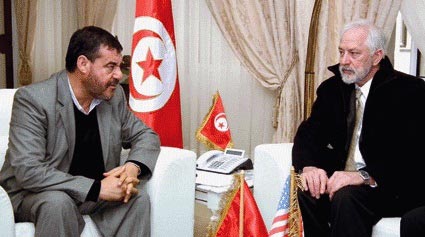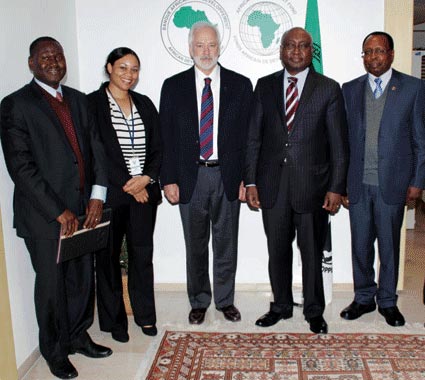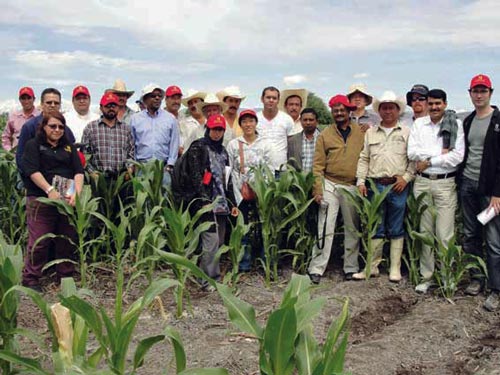DG meets with Tunisian Minister of Agriculture
CIMMYT’s director general Thomas Lumpkin met with Mohamed Ben Salem, the Minister of Agriculture of Tunisia, on 11 February 2012 in Tunis, Tunisia, during a visit to the region focusing on fortifying CIMMYT’s presence in Africa. From CIMMYT, Lumpkin was accompanied by Wilfred Mwangi, liaison officer for Africa, and Karim Ammar, head of the durum wheat program and a Tunisian national.
Wheat is currently the number one imported crop into Africa and, at approximately 216 kilos per person per year, the North Africa region has the highest wheat consumption per capita in the world. Tunisia already imports an estimated 2 million tons of wheat per year, and with low yields and a growing population, wheat production is a major concern for the country. 61% of Tunisia’s total land area is categorized as arid, and erratic rainfall and weather patterns are the primary concern for the country’s wheat producers. In 2010, for example, an extended period of drought halved the country’s wheat production. Diseases and pests such as Hessian fly also cause problems.

During the meeting, which aimed at re-establishing links and partnerships in the region, Lumpkin and Ben Salem discussed opportunities for activities in line with the WHEAT CGIAR Research Program (CRP) lead by CIMMYT in partnership with ICARDA. They talked about improved varieties and agronomic techniques developed at CIMMYT, and the potential for establishing a research platform in Tunisia aimed at achieving higher yields.
CIMMYT’s activities in Tunisia date back to the period 1966-1977, when a comprehensive project known as “The Wheat Project” was implemented by the Government of Tunisia, CIMMYT, USAID, the Ford Foundation, and the Rockefeller Foundation. The goals of the project were to introduce and adapt Mexican semi-dwarf high-yielding wheat varieties and to train Tunisian scientists in agricultural research and extension methods. During the project, 55 Tunisian nationals were trained at CIMMYT in Mexico, and to this day many refer to the varieties developed as “Mexican wheats”.
Lumpkin continued with his visits to the region by heading to Rabat, Morocco to meet with officials alongside Mahmoud Sohl, director general of ICARDA, to link activities in the region with the WHEAT CRP. He also joined CIMMYT’s Hans Braun, director of the global wheat program and Cheraé Robinson, director of fundraising and strategic partnerships, at the Global Food Security Forum, held in Rabat during 07-09 March 2012, where he spoke as a panelist on the subject of Investment and Innovation: Key Building Block of Food Security. Lumpkin will end his recent tour of Africa in Tanzania for the annual meetings of the Sustainable Intensification of Maize- Legume Cropping Systems for Food Security in Eastern and Southern Africa (SIMLESA) project at the end of March.
 The group also discussed the MAIZE CRP and CIMMYT’s strong partnership with the International Institute of Tropical Agriculture (IITA). Institutional linkages such as these can be very beneficial to African smallholder farmers, as demonstrated by the major projects accomplished by CIMMYT’s Africa offices, such as Drought Tolerant Maize for Africa (DTMA), Sustainable Intensification of Maize- Legume Cropping Systems for Food Security in Eastern and Southern Africa (SIMLESA), Water Efficient Maize for Africa (WEMA), Insect Resistant Maize for Africa (IRMA), and Improved Maize for African Soils (IMAS). “CIMMYT has had an enormous impact on wheat in Africa. Most cultivars are CIMMYT derived and many wheat scientists from African NARS have been trained at CIMMYT,” said Ammar.
The group also discussed the MAIZE CRP and CIMMYT’s strong partnership with the International Institute of Tropical Agriculture (IITA). Institutional linkages such as these can be very beneficial to African smallholder farmers, as demonstrated by the major projects accomplished by CIMMYT’s Africa offices, such as Drought Tolerant Maize for Africa (DTMA), Sustainable Intensification of Maize- Legume Cropping Systems for Food Security in Eastern and Southern Africa (SIMLESA), Water Efficient Maize for Africa (WEMA), Insect Resistant Maize for Africa (IRMA), and Improved Maize for African Soils (IMAS). “CIMMYT has had an enormous impact on wheat in Africa. Most cultivars are CIMMYT derived and many wheat scientists from African NARS have been trained at CIMMYT,” said Ammar. “It is very difficult to find conservation agriculture machinery. You have to go to China or India to get it,” said Mahesh Kumar Gathala, new CIMMYTBangladesh-based cropping systems agronomist for South Asia. Gathala, a native of India, was just one of the 15 participants invited to attend a five-week conservation agriculture course at CIMMYT-El Batán, Mexico, where improving machinery and professional capacity were hot topics.
“It is very difficult to find conservation agriculture machinery. You have to go to China or India to get it,” said Mahesh Kumar Gathala, new CIMMYTBangladesh-based cropping systems agronomist for South Asia. Gathala, a native of India, was just one of the 15 participants invited to attend a five-week conservation agriculture course at CIMMYT-El Batán, Mexico, where improving machinery and professional capacity were hot topics.